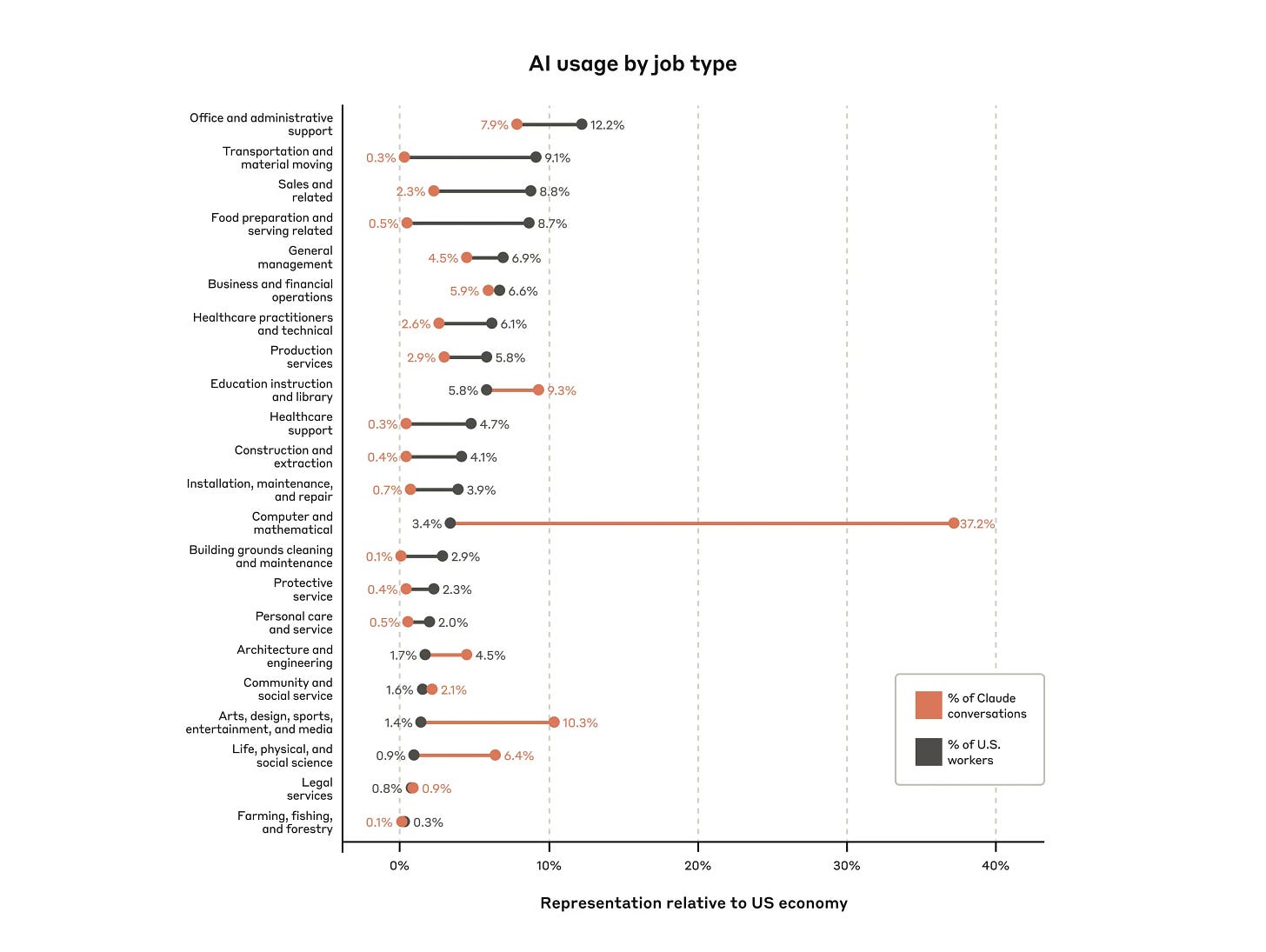AI Has Already Come For Your Job
Forget the future, AI’s already here. This is about creative extinction, not just disruption. And what comes after.
👋🏼, I’m Adam.
I write about the intersection of technology and… everything, but almost always through the lens of culture and society. I cover whatever technology is currently chewing up and spitting out, where it’s all headed, what’s breaking (most of it), and what comes next (lots!).
Consider subscribing for the full edition—or don’t, but then you’ll probably just get the AI-generated summary.
Try not to be shocked: The politicians fucked up the AI Action Summit.
Instead of addressing AI’s existential risks, they pretended everything was fine—despite AI CEOs practically begging for guardrails. So let’s be blunt: things are going to get bad much faster than you think. Then worse. And then, maybe, better.
Why? Because AI is no longer just a technology—it’s a weapon. And in a world where whoever controls AI controls the future, no country is willing to be left behind.
With Trump back in office, propped up by American AI technocrats who see unrestrained AI development as a strategic necessity, the global AI race has shifted from competition to survival. It’s no longer about innovation—it’s about power.
The fear isn’t AI itself. It’s AI dominance. Either by the US, or by China. And the rest of the world has realised they have two choices: accelerate, or be left behind.
That’s why some weird European shit is quietly going down:
Macron and France, once cautious, have flipped to full-speed acceleration
The UK quietly dropped AI safety regulations, despite leading the charge just a year ago (how quaint)
UK’s Labour, ironically, is now bending to Conservative Washington—desperate to stay in the AI race—after it was the British Conservatives, of all people, who were pushing for AI safety in the last administration.
And if you need proof that the AI Action Summit was an empty PR exercise, look no further than Dario Amodei, the CEO of Anthropic. He attended. And then he all but said it was a waste of time. His statement made it clear: the summit lacked focus, failed to address the security risks of AI, and completely ignored the economic devastation that’s coming. A meeting designed to reassure the public instead confirmed that global leaders have no real plan beyond blind acceleration.
That same week, since the governments won’t tell you the bad news, the AI companies now are! Anthropic released its Economic Index, tracking how AI is already automating human jobs. And if the data tells us anything, it’s that the disruption isn’t decades away—it’s happening now.
The result? An AI arms race with no off switch. No guardrails. No oversight. Just raw acceleration.
And why is raw acceleration a problem? Because Artificial General Intelligence (AGI) is coming faster than expected:
Society is not ready. The story we’ve been told—that AI’s impact will be a gradual transition—is a lie. The reality? We are facing an economic tsunami that will displace millions of jobs before governments even react.
If you think I’m full of shit, as Uncharted Territories so aptly showed: A few months ago, a Computer Science (CS) career fair was canceled in San Francisco because no companies wanted to hire anybody!
Remember when CompSci was your best bet for guaranteed employment and high wages? Yah, that’s gone. As of now. Okay, enough preamble, let’s get to it.
Here’s what we need to talk about today:
The Five Industries Facing Immediate AI Disruption – Which sectors will see the fastest job losses and transformations.
The Economic Shockwave – How AI is eliminating jobs at an unprecedented rate and widening inequality.
Who Survives, Who Doesn’t – The roles that will vanish, the ones that will thrive, and what skills might still matter.
The “Bad Gap” – Why the economic transition will be brutal before AI starts creating new jobs (if it ever does).
Which Countries Are Most at Risk – How different economies—US, UK, Europe, China, and India—will be hit by AI automation.
Why Governments Won’t Save You – How political cowardice, corporate pressure, and economic self-interest will ensure that AI safety is ignored.
Buckle up. The AI era isn’t coming—it’s here.
The Five Industries AI Will Disrupt the Fastest
1. Software Development & IT (High Impact, Fast Transition)
💥 Impact Level: 9/10 | ⏳ Timeframe: 1–3 years
Data:
AI already handles debugging, code generation, and network troubleshooting (Anthropic Economic Index).
OpenAI’s o3 model ranks as one of the top 175 coders in the world, demonstrating that AI can now compete with human developers at an elite level.
Klarna, Amazon, and other firms have already reduced their developer workforce, citing AI efficiencies.
Recent projections indicate that AI coding assistants will reduce the need for human developers by 30-40% within five years.
Jobs at Risk: Junior & mid-level developers, QA testers, DevOps engineers.
Survivors: Engineers specialising in AI integration, safety, and system optimisation. Those focusing on system architecture and AI-human collaboration will be in higher demand.
🛑 Stop studying: Basic coding, frontend web development, manual QA testing.
✅ Start learning: AI-assisted development, system architecture, cybersecurity, and AI integration.
⚡ Key survival skill: Master how to work with AI tools—not compete against them.
2. Customer Support & Call Centres (Immediate Impact)
💥 Impact Level: 10/10 | ⏳ Timeframe: 6–18 months
Data:
AI currently handles 75% of customer service tasks, including resolving basic queries and processing complaints (Anthropic Economic Index).
AI-powered virtual agents can now outperform human agents in response time and accuracy while reducing operational costs by up to 60%.
Companies like British Airways and HSBC have already integrated AI-driven chatbots, leading to a 15-20% reduction in customer service roles.
AI’s ability to process vast amounts of data enables it to predict customer needs, further reducing reliance on human agents.
Jobs at Risk: Call centre agents, chat support, Tier 1 IT help desk.
Survivors: Complex case managers, high-value customer success roles that require deep relationship management and critical thinking.
🛑 Stop studying: Basic customer service scripts, low-level call handling.
✅ Start learning: Conflict resolution, high-value customer success, AI chatbot management, and complex case handling.
⚡ Key survival skill: Become the human AI can’t replace—handling escalations, negotiations, and high-touch customer service.
3. Content Creation & Marketing (Fast Impact, Medium Transition)
💥 Impact Level: 8/10 | ⏳ Timeframe: 1–3 years







